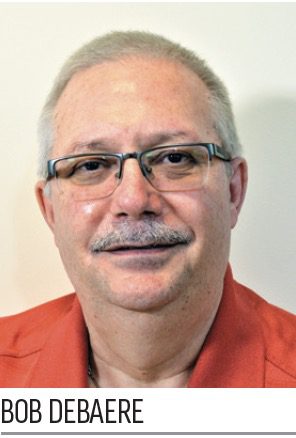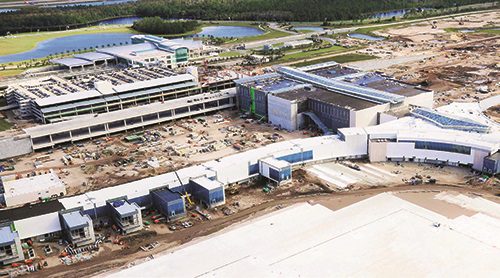When Orlando International Airport (MCO) opens its new South Terminal Complex in early 2022, the facility’s gleaming glass façade, airy environs and high-tech features will no doubt impress passengers. But largely invisible technology will also be working on the tarmac to enhance their experience: a virtual ramp control system designed to minimize gate delays.
When Orlando International Airport (MCO) opens its new South Terminal Complex in early 2022, the facility’s gleaming glass façade, airy environs and high-tech features will no doubt impress passengers. But largely invisible technology will also be working on the tarmac to enhance their experience: a virtual ramp control system designed to minimize gate delays.
 The $7 million system, believed to be the first for a U.S. Category X airport, was engineered to improve ramp safety and efficiency in the near-term and into the future, when the South Terminal Complex eventually has 27 gates. Currently, the Florida airport is in the midst of a $2.7 billion capital improvement program that will allow it to handle an additional 12 million annual passengers decades from now.
The $7 million system, believed to be the first for a U.S. Category X airport, was engineered to improve ramp safety and efficiency in the near-term and into the future, when the South Terminal Complex eventually has 27 gates. Currently, the Florida airport is in the midst of a $2.7 billion capital improvement program that will allow it to handle an additional 12 million annual passengers decades from now.
“The biggest benefit of virtual ramp control is that we’ll control the aircraft coming in and out of the gates, as opposed to the airline carriers scheduling the gates,” explains Bob DeBaere, assistant director of airport operations. “The intent is to have the South Terminal 100% common use, where no airlines will lease or operate gates.”
|
Project: Virtual Ramp Control System Location: Orlando (FL) Int’l Airport 2019 Passenger Volume: 50.6 million Approx. Cost: $7 million Funding: General airport revenue Slated for Activation: Early 2022 Engineering Consultants: Burns Engineering; Barich Inc.; GCI Consultants LLC System Design & Installation: Saab Sensis Cameras: Bosch Multilateration Sensors: Saab Sensis Anticipated Benefits: Eliminating line-of-sight issues; enhancing safety & efficiency of busy ramp; improving aircraft & passenger flow; decreasing fuel burn associated with gate delays; facilitating future ramp expansion; supporting common-use gate policy |
The rest of MCO will maintain both preferential and priority use, creating a hybrid system at one of the country’s busiest and fastest-growing airports.
The cutting-edge ramp technology will complement high-tech features inside its new terminal, such as facial recognition software at security checkpoints for international flights, a high-speed baggage system and large-scale interactive media.
“Passengers should expect a more efficient process when airplanes land and go to this new terminal, and that’s what they’ll get,” says Matthew Meier, aviation special projects lead at Burns Engineering, one of the design consultants on the virtual ramp control project. “Getting the right plane to the right spot at the right time should be a much easier process.”
The system also supports FAA efforts to reduce fuel consumption. The strategy is to help airlines burn less fuel by reducing the time planes spend taxiing, avoiding trips to wrong gates and eliminating the wait-time that occurs when a flight that is assumed to have departed is still at a gate.
“With this system, airplanes will only get sent to a gate the airport knows is open,” Meier explains. “Ultimately, people will get out of planes and out of the airport faster. No one likes to sit in a plane, wondering what’s going on. So anything that makes the process more efficient is good.”
Tower Quandary
Officials at MCO began considering virtual ramp control technology in 2018 because of line-of-sight issues that emerged regarding a proposed ramp tower for the new terminal. Ramp controllers would only be able to see planes up to the point where they entered the ramp area, DeBaere explains.
“There was a blind spot that the FAA said we had to address,” he says. “So we put out industry feelers to find out what kind of technology was out there that might eliminate
the need for a tower.”
Barich Inc. and GCI Consultants helped airport officials select a virtual ramp control system by Saab Sensis.
In a nutshell, the system uses a mix of cameras, radar and sensors to provide an unobstructed view of planes either at the gates or arriving from/departing for runways. (The first phase of the South Terminal project will include 15 gates with 19 aircraft parking spaces.) Live footage from the ramp and gate areas is displayed on an expansive video wall with several large, high-resolution monitors arranged in a grid pattern.
“Think of it as a digital virtual window—a bunch of displays stitched together,” Meier says. “In this case, it’s about six displays wide and two displays high, with an extra one at each end. Together, the displays provide one seamless image.”

Cameras & Sensors
The system designed for MCO includes 15 high-resolution infrared cameras from Bosch strategically placed to provide better sightlines and broader views than a fixed tower. Dozens of other cameras, also made by Bosch, will provide additional views of loading docks and other areas.
“Each camera offers limited views, so you have to fan out multiple cameras across the ramp,” Meier explains.
Additionally, the system employs 31 multilateration sensors from Saab Sensis to pick up signals from airplane transponders for another layer of location-detection capability. Sensors can also be attached to tugs to help controllers monitor their locations, adds Meier.
Data sent by the multilateration sensors allows controllers to “see” the real-time location of aircraft on the ramp and at gates via individual desktop monitors. The monitors provide an overhead view that mimics the view from a conventional ramp tower.
“Taking data from multiple sources allows controllers to get aircraft to the right gate at the right time,” Meier says. “They can track very precisely the location of aircraft on the ground—not only through the ‘window’ view, but on a plan view (from an overhead perspective) of all the different gates.”
Scalability is another advantage of virtual ramp control technology. For example, as MCO expands its terminal and adds ramps in the years ahead, it can simply add more cameras, sensors and video monitors. Investing in a technology platform instead of building more brick-and-mortar towers costs less and conserves valuable airfield land, Meier notes.
Furthermore, because ramp controllers aren’t isolated in towers, they can interact more easily with supervisors and other staff. At MCO, the ramp controllers’ area is located right next to the airport operations center, which facilitates communication.
Is It a Fit?
When deployed, MCO’s new virtual ramp control system will enable it to operate the South Terminal as a common-use facility. This provides more flexibility to efficiently park planes where space is available, as opposed to directing plans to gates according to airline lease agreements.
Beyond the tactical advantages, common-use systems can also help level the playing field for airlines regarding gate access.
“When carriers have leased areas, the airlines will do ‘land grabs’…when gates become available, one airline will try to grab them so no one else can have them,” DeBaere explains. “But with common use, that’s not possible. Everyone has equal opportunities for expansion.”

Meier agrees that virtual ramp control systems dovetail well with common-use policies. “It makes for highly flexible operations because gates aren’t tied to whoever leases and operates them,” he remarks.
Although the various technologies used for MCO’s new system have been around for a while, combining them for virtual ramp control is a relatively new concept, Meier says. Fort Lauderdale-Hollywood International Airport started using a similar system in 2017, and various airports in the United Kingdom, Australia, Norway and Ireland also currently use the technology.
“It’s going to become more and more common,” Meier predicts. “The cost is lower than a traditional ramp tower, and it’s easier to staff and expand.”
He notes that virtual ramp control technology is a great fit for MCO because it operates its own ramps. “They’re also technically fluent and used to looking at technology to solve problems,” he adds.
When it comes to implementing such technology, DeBaere advises other airports to find industry experts that can walk them through various system options. “That’s definitely No. 1,” he says. “And No. 2, of course, is understanding your own facility and its unique requirements.”


 facts&figures
facts&figures

